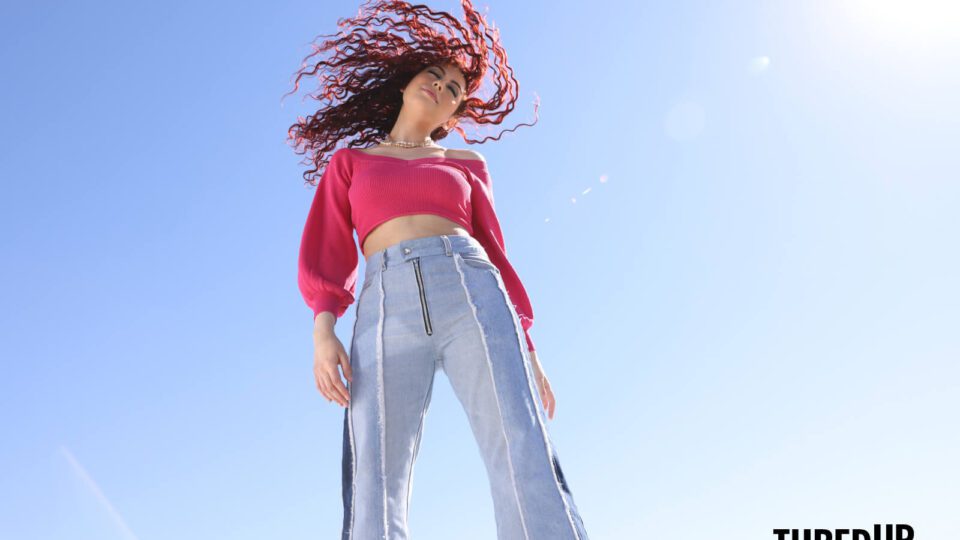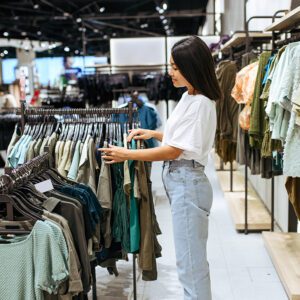As it has for several years, the resale market continues to grow — and the current headwinds other retailers are facing in this moment of economic chaos may actually act as tailwinds for the continued growth of resale.
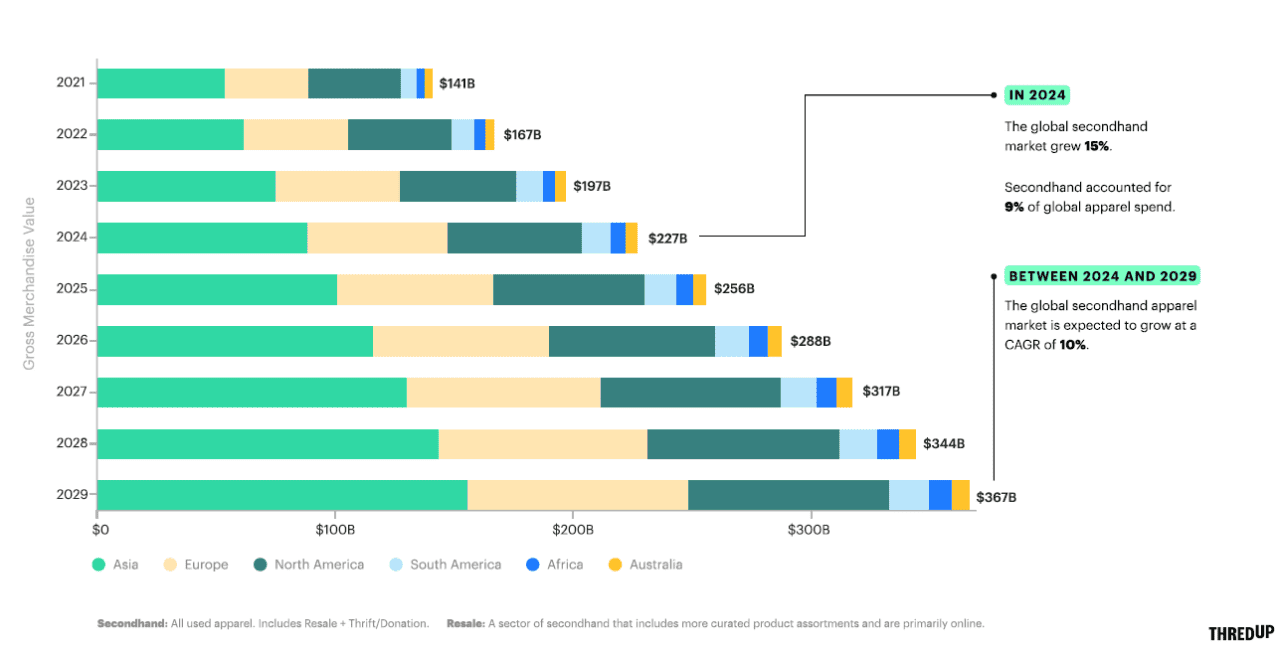
In 2024, the U.S. secondhand market saw its strongest annual growth since 2021, outpacing the broader retail clothing market by 5X and growing 14%, according to resale platform ThredUp’s 13th annual Resale Report. Conducted by retail analytics firm GlobalData, the report predicts that the global secondhand apparel market will reach $367 billion by 2029, with the U.S. secondhand apparel market expected to reach $74 billion by 2029, growing 9% annually on average over the next four years.
Online resale is growing even faster, having marked 23% growth in 2024, and is expected to nearly double in the next five years to reach $40 billion by 2029. This growth is being driven by accelerated consumer adoption, with 58% of consumers saying they shopped for secondhand apparel in 2024, an all-time high for the survey. And that number is even higher among younger generations (ages 18-44), with 68% of that cohort shopping secondhand in 2024.
“As consumers are increasingly thinking secondhand first, the retail industry is adopting powerful new pathways for resale,” said James Reinhart, CEO of ThredUp in a statement. “From the integration of social commerce and innovative AI applications to the establishment of trade organizations and interfacing with government, it’s clear why resale is seeing accelerated growth and has such a promising growth trajectory.”
Advertisement
“In general, retail is struggling at the moment, and resale stands out primarily because it’s a value play,” added Alon Rotem, Chief Strategy Officer at ThredUp in an interview with Retail TouchPoints. “Amid consumer wallet share challenges, people are being more discerning, looking for value, and that’s what resale is offering.”
Resale has several other advantages that are fueling its growth beyond offering value, including:
- A supply chain that is largely domestic, something that is increasingly appealing amid tariffs and supply chain disruptions;
- Resale and trade-in programs are proving to be a powerful customer acquisition tool for brands;
- A shift in cultural attitudes toward secondhand goods, particularly among younger generations; and
- Advances in AI that are making it easier than ever to shop used first online.
Resale’s Economic Advantages: Value and Domestic Supply
As with almost every category at the moment, the impact of President Trump’s game of tariff chicken is having a deep impact on consumer sentiment and shopping strategies: 62% of consumers said they’re concerned that new government policies around tariffs and trade will make apparel more expensive, and 59% said that if that does happen, they will seek more affordable options like secondhand. This figure is highest among millennials, at 69%. In fact, consumers already plan to spend 34% of their apparel budget on secondhand in the next 12 months.
These concerns are even higher among retail executives, 80% of which said they expect new government policies around tariffs and trade to disrupt their global supply chain. As a result, 44% of retail executives are looking to reduce reliance on imported goods, and 54% of retail executives said they believe resale offers a more stable and predictable source of clothing supply in the face of potential tariff fluctuations.
“If you’re a retailer and you’re trying to plan out the next couple of years in terms of how much you’re going to buy or how much you’re going to produce, there is a lot of uncertainty in that planning cycle,” said Rotem. “With resale — I can speak to ThredUp specifically, but I think it’s true more broadly, as well — the supply chain is domestic. It’s coming from the closets of Americans; therefore, there’s much more certainty in terms of how it will be treated from a taxes and tariff standpoint.
“You see the government looking at policies like the America’s Act, which is trying to fight the de minimus loophole for fast fashion coming from China, for example, and trying to emphasize ways to reshore and bring manufacturing back to the United States,” Rotem added. “Resale is a readily available alternative, because the clothing has already been made, it’s already here, and it’s easy for retail platforms to access and for consumers to find it.”
Online Resale Still in its ‘Adolescent Phase’ Despite Consumer Enthusiasm
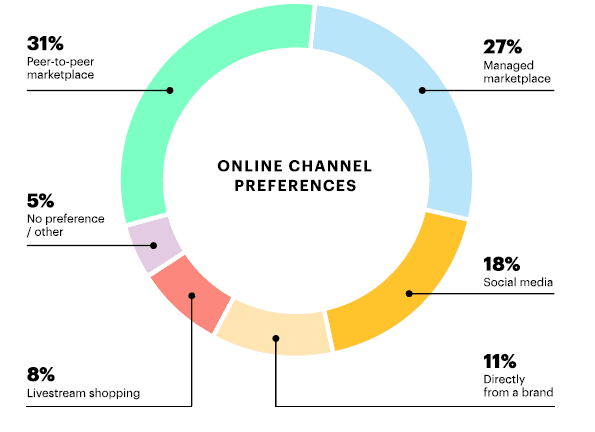
Even outside of the current tariff-induced turmoil, retailers would be hard-pressed to ignore the growing consumer preference for secondhand: 47% of consumers said resale value is an important factor when they consider purchasing new apparel, and 49% said they have cut back on buying cheap, lower-quality apparel because they can’t resell it.
“Almost all retail executives, 94% of them, understand that their consumers are already participating in resale,” said Rotem. “At the same time, 86% of retail executives said they don’t really know how to make it work for their brand. The retail-resale connection is still very much in its adolescent phase. It needs to grow up, and that bridge needs to happen.”
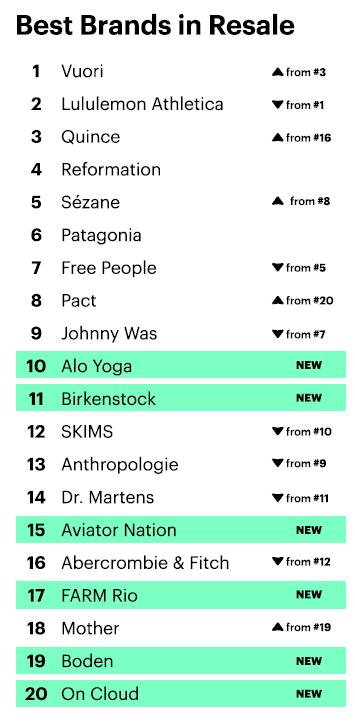
There are big advantages for retailers that can create this bridge: 47% of consumers are more likely to make a first-time purchase with a brand if that brand offers a shopping credit for trading in used apparel, up 25 points from last year’s survey. Additionally, 40% of customers said they prefer to buy a secondhand item from a brand before committing to purchasing new for the first time — up 17 points from 2023 — pointing to the power of resale as a customer acquisition tool. In fact, 32% of consumers who bought secondhand apparel in 2024 made a purchase directly from a brand (47% among younger generations).
The most popular brands in resale last year, based on sell-through and volume of sold items on ThredUp, include Vuori, Lululemon, Quince, Reformation, Sézane, Patagonia, Free People, Pact, Johnny Was and Alo Yoga. Among the brands rising in popularity are The Limited, Sanctuary, Louis Vuitton, Spanx and Champion.
Resale’s Social Advantage: Tapping into the Zeitgeist

Across the 2025 ThredUp report, almost every metric tracking resale and secondhand adoption was higher among younger generations. In fact, 48% of younger generations said that when they are shopping for apparel, they look at secondhand options first before they check out new products.
Given the clearly powerful draw of resale among younger shoppers, it should come as no surprise that one of their primary discovery points is social media — 39% of younger shoppers said they have made a secondhand apparel purchase on a social commerce platform in the last 12 months, compared to 28% of consumers overall.
Of those who have, 62% did so on TikTok, but other top platforms include Facebook Marketplace, Instagram, YouTube and Pinterest. Much of this activity is driven by influencers and creators, but commerce integrations into these platforms with companies like Shopify are also coming into play, making it easier for resellers to create online stores and then promote their inventory on social.
Perhaps even more interesting, half (50%) of younger consumers who purchased secondhand apparel in the last 12 months did so with the purpose of creating content or sharing on social media. This stat in particular points to a marked shift in the zeitgeist around the idea of used goods; while once looked down on by many consumers, buying secondhand is now seen as a virtue, even something to brag about.
ThredUp has seen this shift play out in its own business as well: “The ThredUp story for a long time, like if you go back 15 years ago to our inception, has been to de-stigmatize secondhand,” said Rotem. “Even our motto, ‘Think secondhand first,’ has been all about changing people’s minds. Now we’ve reached a point where when people say they shop resale or they shop secondhand, they’re talking about being smart, about value, they’re talking about sustainability, they’re talking about uniqueness and not looking like everybody else. All of those things have changed the way that we market to consumers. Now it’s less about education and much more about how easy it is to find the things you want so you can fully express yourself.”
How AI is Closing the Gap Between Shopping Used and Shopping New
Advancements in technology making it possible to sell individual used items online have been key to the continued rise of online resale, going back to the early days of Ebay. Now, however, there is so much secondhand inventory available online that 30% of consumers said they feel overwhelmed by the options.
The second wave of advancement in online resale is being driven in large part by AI, which is helping to improve search functionality, personalization and discovery. The prize is large for platforms and retailers that can get this right — 46% of consumers said that if they can find an item secondhand, they won’t buy it new (55% among younger generations), and 49% said that if they could find current trends reflected in secondhand items as easily as new, they’d buy more secondhand.
“Shopping used is inherently more challenging than shopping new, because these items are unique and there’s a much bigger variety,” explained Rotem. “On ThredUp alone, for example, there are 5 million items to choose from. That can be an overwhelming shopping experience.”
Reducing this “thrift overwhelm,” as ThredUp calls it, has been a large focus for the company in the last year and led to advancements in its site search, the addition of image search functionality and a conversational chat function to help customers find what they’re looking for, all powered by AI.
“We’re really bullish on AI helping close the gap between how used is shopped online versus how new is shopped,” said Rotem. “Thrift overwhelm is a real thing, and AI is making a huge dent in it.”



